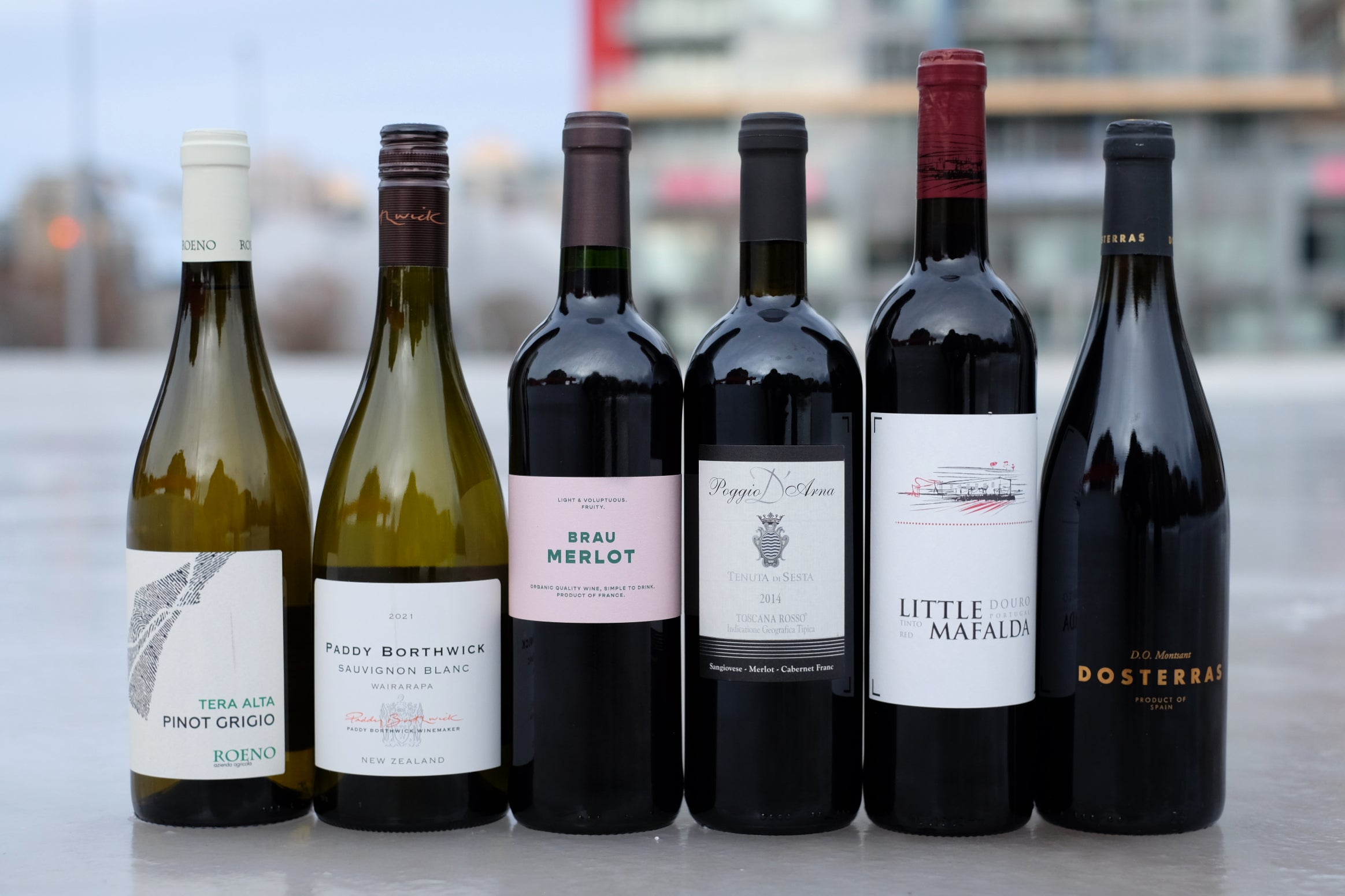| Good morning everyone! We're pleased to introduce our February edition of Vine Arts Wine Club! As always we've searched high and low to discover six new and delicious wines. We're certain this months selections will not disappoint! Cheers! |
| 2020 ROENO Pinot Grigio ‘Terra Alta’ Valdadige Trentino-Alto Adige/Südtirol, Italy $23.99 | Where There are parts of Italy that aren’t very, well, Italian. At least not what we think Italy to be. You have to remember that a unified Kingdom of Italy only came about with the Risorgimento in the 19th century. Before then the Italian peninsula was made up of separate, and often warring, states. Northern situated Trentino-Alto Adige/Südtirol was part of Austria-Hungary until after the end of the war in 1919. Many of the people of this autonomous mountainous region call German their first language. Like with our “chinook”, the Alps cast a rain shadow and maintain a reliable warming breeze. Although high in elevation, summers are surprisingly warm. The region is split into two provinces, with Alto Adige/Südtirol in the north and Trentino in the south. What The wine appellation of Valdadige (known to German speakers as Etschtaler) includes vineyards in both Trentino and Alto Adige/Südtirol, plus a small portion in neighbouring Veneto. The most common grape by some measure is Pinot Grigio. A member of the pinot family of grapes, this variety originated in the vineyards of France, where it is known as Pinot Gris. Interestingly, Pinot Gris is actually identical in appearance to Pinot Noir in the vineyard until veraison, when the grapes begin to darken. The name gris derives from the light gray sheen that appears on the grapes. Northern Italian Pinot Grigio is most often crisp with clear varietal typicity. For the Roeno Pinot Grigio ‘Terra Alta’, the wine was vinfied in stainless steel tanks, with 70% resting on the lees for 6 months. The remaining 30% was aged in barrels, where the wine underwent malolactic fermentation. Who The name of the ROENO winery is an acronym. It derives from the name of the founder Rolando, and from the Greek word for wine, enos. The estate lies at the center of Valdadige Terradeiforti (“the Land of the Fortresses”) north of Verona, in Belluno Veronese. Situated on the border of Trentino and Veneto, Valdadige Terradeiforti was previously a subzone of Valdadige and was given its own DOC in 2006. The winery is managed by Roberta, Cristina and Giuseppe Fugatti, who carry on the traditions of Rolando, who created the estate 50 years ago. Vineyard management and winemaking are in the capable hands of Giuseppe Fugatti. Taste The Pinot Grigio ‘Terra Alta’ is a textbook example of Italy’s most well-known white wine. Pale lemon-green in the glass, on the nose there are delicate aromas of fresh squeezed lime, white nectarine, white peach, and green apple. Light bodied with high acidity, the palate shows brackish minerality and a sprinkle of almond bitterness. The finish is crisp and refreshing. A strong pairing for seafood, salads, and chicken, we suggest serving this Pinot Grigio with filetti di pesce persico fritti o in padella (perch fillets fried or pan roasted). |
| 2021 Paddy Borthwick Sauvignon Blanc Wairarapa, New Zealand $27.95 | Where The New Zealand wine region of Wairarapa is located on the southern tip of the North Island. Less known than the region of Marlborough, it accounts for only 1% of the nation's overall wine output. Meaning “glistening waters" in te reo Māori, Wairarapa is subdivided into three zones around the towns of Masterton, Gladstone, and Martinborough. The region's climate is defined as semi-maritime, and is strongly influenced by the long coastline. To the west and northwest, the Rimutaka and Tararua mountain ranges block cool winds and shelter the vineyards. What Wairarapa’s cool climate makes it a great region to grow cool-climate grape varieties. The most popular white grape variety is Sauvignon Blanc, accounting for about ¼ of all plantings. The most common red grape variety is Pinot Noir, adding up to around ½ of all plantings. In fact, by the time Central Otago had developed a reputation for world class Pinot Noir, Wairarapa had already been making great Pinot Noir for two decades. The Paddy Borthwick Sauvignon Blanc is made from grapes harvested from to blocks of 10 to 16 year old vines planted near Gladstone. Transported to the winery quickly to preserve acidity, the fruit was inoculated with yeast and vinfied in temperature controlled stainless steel tanks. After several months resting on the lees, the wine was blended and bottled without fining or filtration. Who The story of this winery originates with PJ Borthwick, who immigrated to New Zealand from England in 1936. Purchasing the Te Whanga Station 100 km's to the north of Wellington, Borthwick established one of New Zealand’s most successful cattle stations. Maintained by the same family for generations, Te Whanga today is home to 700 Angus cattle and 10,000 sheep grazing on 1600 hectares of land. In the 1980’s PJ Borthwick’s grandson, Paddy, decided to expand outside of the family business, studying viticulture at Roseworthy College in Australia. Gaining work experience around the globe, Paddy created Borthwick Vineyard and Winery in the late 1990’s. Today the estate includes 27 hectares of vineyards planted to stony, free draining, alluvial soils. In the cellar, Briony Carnachan is in charge of winemaking. Taste Compared to the Sauvignon Blanc’s of Marlborough, Wairarapa Sauvignon Blanc is known for riper fruit character and intensely herbaceous aromatics. Medium lemon-green in the glass, the Paddy Borthwick Sauvignon Blanc's nose has aromas of citron lemon, gooseberry, grass and asparagus. The palate is light bodied with high acidity and crunchy minerality. The bone dry finish is refreshing and lingering. Always a good pairing for chalky goat cheese, this white wine is a great option for sake, ahi and hotate sashimi. |
| 2019 Château de Brau Majelus Merlot IGP Pays d'Oc, France $21.80 | Where The Pays d’Oc is an IGP (Indication Géographique Protégée) that covers a large swath of southern France. Sitting apart from the stricter AOC (Appellation d'Origine Contrôlée) system, IGP wines are often referred to as ‘country wines’ or ‘wines of the land’. A vast region that stretches along the Mediterranean coast to the Pyrenees, the Pays d’Oc has a generally Mediterranean climate with hot and dry summers and mild winters. Altogether there are around 120,000 hectares planted to vine, making this one of the largest wine regions in the world. What The whole concept behind the IGP designation is to offer winemakers greater freedom in their winemaking. Rules that have been baked into traditional appellations such as Burgundy or Bordeaux, do not allow for the introduction of different grape varieties or winemaking techniques. If your vineyards exist outside of traditional appellations, you’ll also want to use the IGP designation. Although there are some higher end examples, in general, these wines are well priced and designed for immediate enjoyment. The Château de Brau ‘Majelus’ is made from the wine world's favourite punching bag, Merlot. We can partially thank Paul Giamatti and the movie Sideways for this. Derided by Giamatti’s character Miles, Merlot was already experiencing tough times in the early 2000’s. Merlot was just too popular for its own good in the 90’s. To meet high demand, oceans of poor quality Merlot were produced, tarnishing the reputation of a noble grape variety. Twenty years on from Sideways’ release and Merlot is still recovering. The funny thing is that good Merlot never actually went anywhere and is as delicious as it ever was! Who Sitting opposite the medieval “Cité de Carcassonne” in the shadow of the Pyrenees mountains, lies the Château de Brau. Built in 1877, the structure was purchased in 1982 by Wenny and Gabriel Tari. Along with the château, the couple acquired 15 hectares of vineyards. Prior to their arrival the fruit from these vines were sold to the local cooperative, but they had a different plan in mind. Driven to produce estate wines, they extended their holdings by purchasing another 25 hectares of vineyards. Farming according to organic principles, their vines are planted to Merlot, Cabernet-Sauvignon, Cabernet-Franc, Syrah, Grenache, Fer-Servadou, Egiodola, Petit Verdot, Cinsault, Cot, Chardonnay, Viognier, Ugni blanc and Roussanne. The estate has been certified by Ecocert since 1989. In addition to IGP Pays d'Oc wines, Château de Brau also bottles wines under the Cabardès AOC, a relatively small appellation created in 1999. Taste There's a good reason for Merlot’s popularity in the 1990’s. Ripe and supple flavours of black cherry, red plum, clove and cedar, make it a very pleasing variety. Where things went wrong is when winemakers overdid it. Dumpy fruitiness and sweet oak steered away from Merlot’s charm. The ‘Majelus’ is what a good classic Merlot should be like. Full-flavoured, but very drinkable and fresh. Ruby red in the glass, red fruit aromas are complemented by accents of graphite and clove. The tannins are soft but present. A wonderful everyday kind of wine, the ‘Majelus’ will pair nicely with classic bistro fare like tartare de filet de boeuf and confit de canard. |
| 2014 Tenuta di Sesta Poggio d'Arna Tuscany, Italy Previous price $26.83 | Where The Tenuta di Sesta estate is located in the southern part of the municipality of Montalcino between Sant'Angelo in Colle and Castelnuovo dell'Abate. The area lies about 10 kilometers southeast of the Tuscan hilltop town of Montalcino itself and is known for particularly powerful wines. The climate benefits from warmer temperatures, which promotes ripening, and a ridge which protects the vineyards from searing heat emanating from the coast. Additionally, the area benefits from consistent sunlight and cooling breezes from the Orcia river. Elevations range from 250 to 450 meters above sea level. What The Poggio d'Arna is made from a blend of Sangiovese (known locally as Brunello), Merlot and Cabernet Franc. The name Brunello derives from “bruno”, meaning “brown''. Originally thought to be a distinct variety, in the late 1800’s studies found that Brunello is in fact Sangiovese Grosso, one of the many different clones of Sangiovese. The traditional wine of the region, Brunello di Montalcino, can only be made from 100% Sangiovese Grosso/Brunello. Any wines made from a blend of varieties can be labelled under the Toscana Rosso IGT designation, or when applicable, Sant'Antimo DOC. Fermented traditionally, this wine was aged for one year in a combination of French Allier barriques and 15 hl Slavonian oak barrels. Who The name of the Tenuta di Sesta estate is Roman in origin. It derives from the sixth (“sesta” in Italian) milestone where the Parish Church of Saint Mary of Sexta once stood along the ancient road from Roselle to Chiusi. Owned by the Abbey of Sant'Antimo and the Republic of Siena over the years, it was purchased by Felice and Giovanni Ciacci in 1850. Passed down through the family, the first wines were produced in 1966 by Giuseppe Ciacci. At the time, it was one of the few wineries releasing estate bottled wines. Managed today by Giuseppe's son, Giovanni, Tenuta di Sesta extends across 200 hectares of land, of which 30 hectares are planted to vine. The remaining land is dedicated to growing olives and grain. Taste At over 7 years of age, the Tenuta di Sesta Poggio d'Arna is showing some good maturity. 2014 was a cooler vintage, so typically Tuscan wines from this year are accessible sooner. Medium-full bodied and dark garnet in colour, it displays fleshy notes of dried red cherry, red fig, licorice, espresso and leather. Fine tannins and lean acidity make it a worthy pairing candidate for cinghiale in dolceforte (tuscan wild boar stew with chocolate) or maiale ubriaco (“drunken pork”). |
| 2019 Quinta Dona Mafalda Little Mafalda Douro Valley, Portugal $21.98 | Where Centered on the Douro River in northern Portugal, the Douro wine region is a testament to hard work and plain stubbornness. Steep terraced vineyards planted on thin, sunbaked schist soils, tower over the mosquito populated river below. For 2000+ years grape growers have trudged up and down the 60 degree slopes under the punishing Portuguese sun. Standing in the highest vineyards, everything below takes on the appearance of a topographical map. The orderly terraces built of man-made stone walls, have been recognized by Unesco as a World Heritage site. The Douro River itself is one of the longest rivers of the Iberian Peninsula, flowing from its source through some of neighbouring Spain’s most famous wine regions. Three regions comprise the Douro: the inland Douro Superior, the central Cima Corgo region, and the closer to the ocean Baixo Corgo. The further inland the vineyards go, the more continental and extreme the climate gets. What The Dona Mafalda “Little Mafalda” is made from a cuvée of traditional Douro grape varieties - Tinta Barocca, Tinta Roriz, Touriga Franca and Touriga Nacional. These grapes are commonly used in the region's most widely recognized wine style - fortified Port. While the region's dry wine styles are growing in popularity, and rightfully so, the concentrated sweet wines of the Douro are what most wine drinkers will be familiar with. Whether this will continue to be the case is hotly debated amongst winemakers. A sort of schism has appeared between those who would like to maintain the course, while others argue that dry wines are the future. With demand shrinking for sweet wines globally, we can assume that dry wine styles will be more and more important in the Douro Valley. Who Quinta Dona Mafalda is owned by the Christie’s family, who’ve been producing wine in the Douro for two generations. The family also owns Butler, Nephew & Cº, a historic port house that has been producing Port wines since 1829. The Quinta Dona Mafalda estate includes 7 hectares of vineyards, of which one third is planted to old vines. In the past decade the family have invested heavily in the estate, replanting many of the vineyards and transitioning back to traditional farming practices. Rather than producing the wines at a larger facility offsite, which is common practice in the Douro Valley, they ferment, bottle and store the wines at the quinta. Although the winery was thoroughly modernized, a traditional stone ‘lagare’ (an open stone vat where grapes are crushed by foot) was kept for certain cuvées. The heavy task of producing both the wines of Quinta Dona Mafalda and Butler, Nephew & Cº is in the capable hands of winemaker Carlos Valente. Taste The dry red wines of the Douro Valley are loved for their bold richness. Obtaining full grape ripeness is rarely a problem in a region where summer temperatures can be scorching hot. There is nothing little about the “Little Mafalda”. Deep purple red in colour, the nose exhibits abundant aromas of blueberry, black plum, violet and mocha. The full bodied palate is packed with rich blackfruit flavours, which are framed by smooth tannins and balanced acidity. On the finish there is a soft sprinkle of milk chocolate and vanilla bean spice. We suggest pairing this wine with barbecued meats or firm cheeses, like aged Cheddar or Gruyere. |
| 2015 Dosterras Montsant, Spain Previous price $46.80 Description courtesy of Alex Good, Spur Imports | Where In the warm, sun-drenched, arid Montsant district in northeastern Spain near Barcelona. As a wine region, its history dates back to the 13th century. It is a stark, severe place where vines grow in hot, arid conditions – there is a sparse, deeply earthy/mineral quality to the wines that reflects their origins. The grape varieties consist mostly of Garnacha (Grenahce) and Samso (Carignan). 95% of plantings in the area are red. What Dosterras is not only the name of the winery, but also of this particular wine. It represents a highly traditional style of wine for the region, from the most typical grape variety of Montsant, Garnacha (aka Grenache). These vines, planted in impoverished, sparse, iron oxide rich slate specific to the area called licorella, and are around 100 years old. They produce meagre amounts of concentrated, potent, complex fruit that give dramatic wines with both power and finesse. Who Josep Grau was one of the pioneers of the Montsant appellation, helping to put it on the world wine map. His innovations and work with the land and grape varieties of Montsant, modernizing this sleepy, bucolic part of Spain led to a renaissance of the area, and a renewed interest in the potent, muscular reds of the region. He retired in 2012, passing Dosterras off to the Ibarra family of Mexico. The Ibarra’s, already winery owners of repute in their native Mexico (they own the excellent Sta. Rosa Xajay winery), maintain Grau’s hard work and meticulous attention to detail. They are among the stars of the Montsant region. Taste Dark purple/ruby in colour, saturated all the way to the rim, where it finally fades to a lighter crimson cherry colour. Lovely, dripping Garnacha notes on the nose, showing an earthy mix of crushed rock, kirsch liqueur, ground pepper, cinnamon bark, black cherry, damson plum, fig, and dark chocolate. Big, broad, and nourishing on the palate, with smooth tannins, spicy red fruit flavours, and a charming finish with pointed acidity. |


